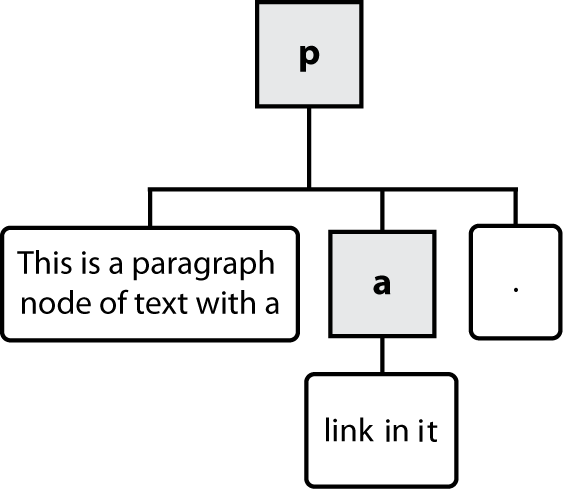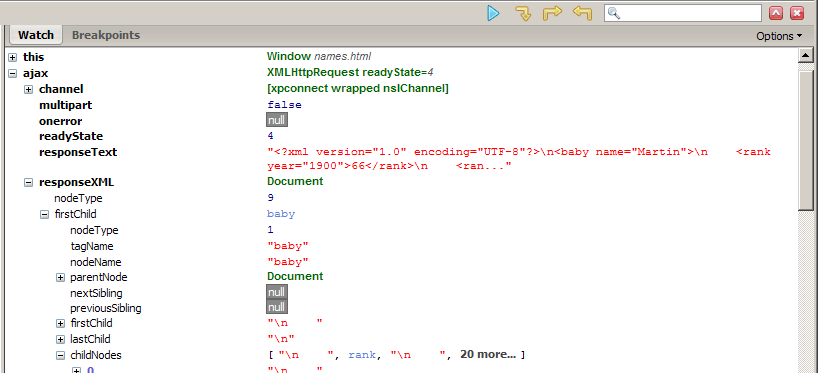Web Programming Step by Step, 2nd Edition
Lecture 23: XML
Reading: 12.3, 12.5
Except where otherwise noted, the contents of this document are Copyright 2012 Marty Stepp, Jessica Miller, and Victoria Kirst. All rights reserved. Any redistribution, reproduction, transmission, or storage of part or all of the contents in any form is prohibited without the author's expressed written permission.
Storing structured data in arbitrary text formats (bad)
My note: BEGIN FROM: Alice Smith (alice@example.com) TO: Robert Jones (roberto@example.com) SUBJECT: Tomorrow's "Birthday Bash" event! MESSAGE (english): Hey Bob, Don't forget to call me this weekend! PRIVATE: true END
- Many apps make up their own custom text format for storing structured data.
- We could also send a file like this from the server to browser with Ajax.
- What's wrong with this approach?
XML: A better way of storing data
<?xml version="1.0" encoding="UTF-8"?> <note private="true"> <from>Alice Smith (alice@example.com)</from> <to>Robert Jones (roberto@example.com)</to> <subject>Tomorrow's "Birthday Bash" event!</subject> <message language="english"> Hey Bob, Don't forget to call me this weekend! </message> </note>
- eXtensible Markup Language (XML) is a format for storing nested data with tags and attributes
- essentially, it's HTML, but you can make up any tags and attributes you want
- lots of existing data on the web is stored in XML format
What is XML?
- XML is a "skeleton" for creating markup languages
- you decide on an XML "language" of tags and attributes that you want to allow in your app
- XML syntax is mostly identical to HTML's:
<element attribute="value">content</element> - the HTML/XML tag syntax is a nice general syntax for describing hierarchical (nested) data
- when you choose to store data in XML format (or access external XML data), you must decide:
- names of tags in HTML:
h1,div,img, etc. - names of attributes in HTML:
id/class,src,href, etc. - rules about how they go together in HTML: inline vs. block-level elements
- names of tags in HTML:
- XML presents complex data in a human-readable, "self-describing" form
Anatomy of an XML file
<?xml version="1.0" encoding="UTF-8"?> <!-- XML prolog --> <note private="true"> <!-- root element --> <from>Alice Smith (alice@example.com)</from> <to>Robert Jones (roberto@example.com)</to> <subject>Tomorrow's "Birthday Bash" event!</subject> <message language="english"> Hey Bob, Don't forget to call me this weekend! </message> </note>
- begins with an
<?xml ... ?>header tag (prolog) - has a single root element (in this case,
note) - tag, attribute, and comment syntax is just like HTML
Uses of XML
- XML data comes from many sources on the web:
- web servers store data as XML files
- databases sometimes return query results as XML
- web services use XML to communicate
- XML is the de facto universal format for exchange of data
- XML languages are used for music, math, vector graphics
- popular use: RSS for news feeds & podcasts
What tags are legal in XML?
<measure number="1"> <attributes> <divisions>1</divisions> <key><fifths>0</fifths></key> <time><beats>4</beats></time> <clef> <sign>G</sign><line>2</line> </clef> </attributes> <note> <pitch> <step>C</step> <octave>4</octave> </pitch> <duration>4</duration> <type>whole</type> </note> </measure>
- any tags you want! examples:
- a library might use tags
book,title,author - a song might use tags
key,pitch,note
- a library might use tags
- when designing XML data, you choose how to best represent the data
- large or complex pieces of data become tags
- smaller details and metadata with simple types (integer, string, boolean) become attributes
XML and Ajax

- web browsers can display XML files, but often you instead want to fetch one and analyze its data
-
the XML data is fetched, processed, and displayed using Ajax
- (XML is the "X" in "Ajax")
- It would be very clunky to examine a complex XML structure as just a giant string!
- luckily, the browser can break apart (parse) XML data into a set of objects
- there is an XML DOM, similar to the HTML DOM
Fetching XML using Ajax (template)

var ajax = new XMLHttpRequest();
ajax.onload = functionName;
ajax.open("GET", url, true);
ajax.send();
...
function functionName() {
do something with this.responseXML;
}
this.responseTextcontains the data in plain text (a string)this.responseXMLis a parsed XML DOM tree object
XML DOM tree structure

<?xml version="1.0" encoding="UTF-8"?> <categories> <category>children</category> <category>computers</category> ... </categories>
- the XML tags have a tree structure
- DOM nodes have parents, children, and siblings
- each DOM node object has properties/methods for accessing nearby nodes
Types of DOM nodes (8.3.1)
<p> This is a paragraph of text with a <a href="/path/page.html">link in it</a>. </p>

 element nodes (XML/HTML tag)
element nodes (XML/HTML tag)
- can have children and/or attributes
 text nodes (text in a block element)
text nodes (text in a block element)
 attribute nodes (attribute/value pair)
attribute nodes (attribute/value pair)
- text/attributes are children in an element node
- cannot have children or attributes
- not usually shown when drawing the DOM tree
Traversing the DOM tree
every node's DOM object has the following properties:
| name(s) | description |
|---|---|
firstChild, lastChild
|
start/end of this node's list of children |
childNodes
|
array of all this node's children |
nextSibling, previousSibling
|
neighboring nodes with the same parent |
parentNode
|
the element that contains this node |
- complete list of DOM node properties
- other properties:
nodeName,nodeType,nodeValue
Interacting with XML DOM nodes

To get a list of all nodes that use a given element:
var elms = node.getElementsByTagName("tag");
To get the text inside of a node:
var text = node.firstChild.nodeValue;
To get an attribute's value from a node:
var attrValue = node.getAttribute("name");
Differences from HTML DOM
Can't get a list of nodes by id or class using getElementById or querySelectorAll:
var elms =document.querySelectorAll("#main li");document.getElementById("id");
Can't get/set the text inside of a node using innerHTML:
var text =document.getElementById("foo").innerHTML= "hi";
Can't get an attribute's value using .attributeName:
var imageUrl =document.getElementById("myimage").src= "foo.jpg";
Full list of XML DOM properties
- properties:
nodeName,nodeType,nodeValue,attributesfirstChild,lastChild,childNodes,nextSibling,previousSibling,parentNode
- methods:
getElementsByTagName,getAttribute,hasAttribute,hasChildNodesappendChild,insertBefore,removeChild,replaceChild
- full reference
Ajax XML DOM example
<?xml version="1.0" encoding="UTF-8"?> <employees> <lawyer money="99999.00" /> <janitor name="Ed"> <vacuum model="Hoover" /> </janitor> <janitor name="Bill">no vacuum, too poor</janitor> </employees>
// how much money does the lawyer make? var lawyer = this.responseXML.getElementsByTagName("lawyer")[0]; var salary = lawyer.getAttribute("money"); // "99999.00" // array of 2 janitors var janitors = this.responseXML.getElementsByTagName("janitor"); var vacModel = janitors[0].getElementsByTagName("vacuum")[0].getAttribute("model"); // "Hoover" var excuse = janitors[1].firstChild.nodeValue; // "no vacuum, too poor"
- How would we find out the first janitor's name?
- How would we find out how many janitors there are?
- How would we find out how many janitors have vs. don't have vacuums?
Larger XML file example
<?xml version="1.0" encoding="UTF-8"?> <bookstore> <book category="cooking"> <title lang="en">Everyday Italian</title> <author>Giada De Laurentiis</author> <year>2005</year><price>30.00</price> </book> <book category="computers"> <title lang="en">XQuery Kick Start</title> <author>James McGovern</author> <year>2003</year><price>49.99</price> </book> <book category="children"> <title lang="en">Harry Potter</title> <author>J K. Rowling</author> <year>2005</year><price>29.99</price> </book> <book category="computers"> <title lang="en">Learning XML</title> <author>Erik T. Ray</author> <year>2003</year><price>39.95</price> </book> </bookstore>
Navigating node tree example
// make a paragraph for each book about computers var books = this.responseXML.getElementsByTagName("book"); for (var i = 0; i < books.length; i++) { var category = books[i].getAttribute("category"); if (category == "computers") { // extract data from XML var title = books[i].getElementsByTagName("title")[0].firstChild.nodeValue; var author = books[i].getElementsByTagName("author")[0].firstChild.nodeValue; // make an HTML <p> tag containing data from XML var p = document.createElement("p"); p.innerHTML = title + ", by " + author; document.body.appendChild(p); } }
Exercise: Late day distribution
- Write a program that shows how many students turn homework in late for each assignment.
- Data service here:
http://webster.cs.washington.edu/cse154/hw/hw.php- parameter:
assignment=hwN
- parameter:
Exercise: Animal game
- Write a program that guesses which animal the user is thinking of. The program will arrive at a guess based on the user's responses to yes or no questions. The questions come from a web app named
animalgame.php.

Practice problem: Animal game (cont'd)
- The data comes in the following format:
<node nodeid="id"> <question>question text</question> <yes nodeid="id" /> <no nodeid="id" /> </node>
<node nodeid="id"> <answer>answer text</answer> </node>
- to get a node with a given id:
animalgame.php?nodeid=id - start by requesting the node with
nodeidof1to get the first question
Attacking the problem
Questions we should ask ourselves:
- How do I retrieve data from the web app? (what URL, etc.)
- Once I retrieve a piece of data, what should I do with it?
- When the user clicks "Yes", what should I do?
- When the user clicks "No", what should I do?
- How do I know when the game is over? What should I do in this case?
Debugging responseXML in Firebug

- can examine the entire XML document, its node/tree structure
Schemas and Doctypes
- "rule books" describing which tags/attributes you want to allow in your data
- used to validate XML files to make sure they follow the rules of that "flavor"
- the W3C HTML validator uses an HTML schema to validate your HTML (related to
<!DOCTYPE html>tag)
- the W3C HTML validator uses an HTML schema to validate your HTML (related to
- these are optional; if you don't have one, there are no rules beyond having well-formed XML syntax
- for more info:
- W3C XML Schema
- Document Type Definition (DTD) ("doctype")

